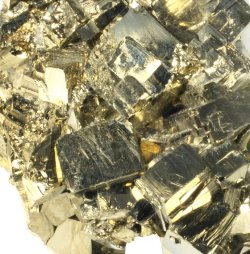
|
Pyrite (FeS2) is an iron sulphide with a distinctive, pale brass-yellow colour, often occurring as streaks in quartz. Its name comes from the Greek word "Pyr" meaning 'fire' because Pyrite gives off a characteristic spark when it is struck sharply. Pyrite looks very similar to gold and this has caused many amateur prospectors to mistakenly believe they are about to become rich. For this reason, Pyrite is better known by its unofficial name of "Fool's Gold". Ironically, it turns out that there sometimes is real gold to be found in Pyrites and these can form quite large deposits. These are often called 'invisible deposits' because - unlike gold ore deposits where pure gold can be found as gold nuggets - the gold in Pyrite canít be seen by the naked eye and can only be extracted chemically. |
|
|
In the Earth's crust, the element gold (Au) occurs in concentrations of 2.5 parts per billion (ppb), i.e. as a very small amount. For gold to be viable for mining, the concentration of gold has to be in pockets at least 1000 times denser. So how much gold can pyrites hide? The largest deposits of invisible gold are in Nevada in so-called Carlin-type deposits. In fact some geologists believe that these deposits contain the second largest accumulation of gold on Earth. They make up more than 5% of current global gold production and constitute 75% of US gold production. (The largest accumulation is in Indonesia, which is currently the world's 7th largest gold producer.) In the Nevada deposits the gold bound to pyrite has whole rock concentrations of between one and tens of grams per ton of rock material (1000 to 10.000 ppb). But why do some pyrites contain gold while others donít? And how does the gold end up in pyrites? This was recently addressed by a group from the German Research Centre for Geosciences in Potsdam. Their aim was to reproduce the process of Au sequestration in pyrites in a laboratory setting. It has been observed that invisible gold deposits often go together with high concentrations of arsenic (As) so the authors began with the hypothesis that arsenic is key in this process. Christof Kusebauch and his colleagues started by growing pyrite crystals. Mimicking the natural ore system, the authors used iron-rich carbonates and sulphur-rich solutions. Then they added arsenic and gold to the mix. "The major challenge was to experimentally grow gold and arsenic bearing pyrite crystals that were big enough to analyze." - Christof Kusebauch remarked. Once this was achieved, the team found that higher concentrations of arsenic resulted in more gold becoming incorporated into pyrite. In fact the coupled partitioning behaviour of these two trace elements was key to gold precipitation. The technical details are as follows: The enrichment of Arsenic in pyrite caused more efficient partition of Au between fluid and pyrite, producing pyrite that can effectively adsorb Au-HS complexes from the fluid onto the pyrite surface. Reactive iron (Fe) released from Fe-bearing carbonates competed for sulphur, thus destabilizing the adsorbed Au-HS complexes and using the S of the complex to produce pyrite that rich in structurally bound Au+1. In addition to arsenic, the researchers found that precipitation of large amounts of fine-grained, or porous, pyrite with a large surface area is favorable for the formation of Au deposits. These new findings should help to track down new gold deposits. Ideally geologists should look for locations where hot solutions containing gold and arsenic from magmatic sources have passed through sedimentary rocks with abundant small grains of pyrites. 'Fools gold' may not be so foolish after all. Journal Reference: | |
| _______________________________ | ||||
| Home | | | Shopping | | | Database |
© Biscuit Software 2004-2018
All rights reserved